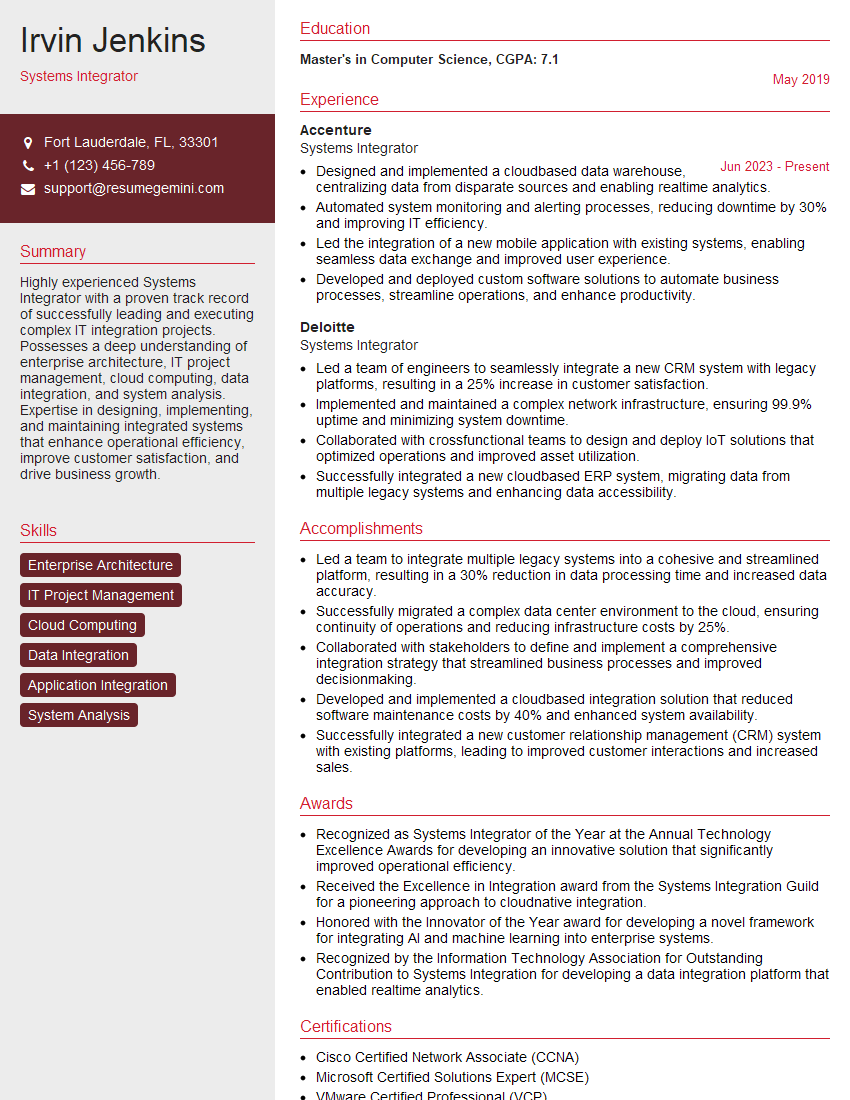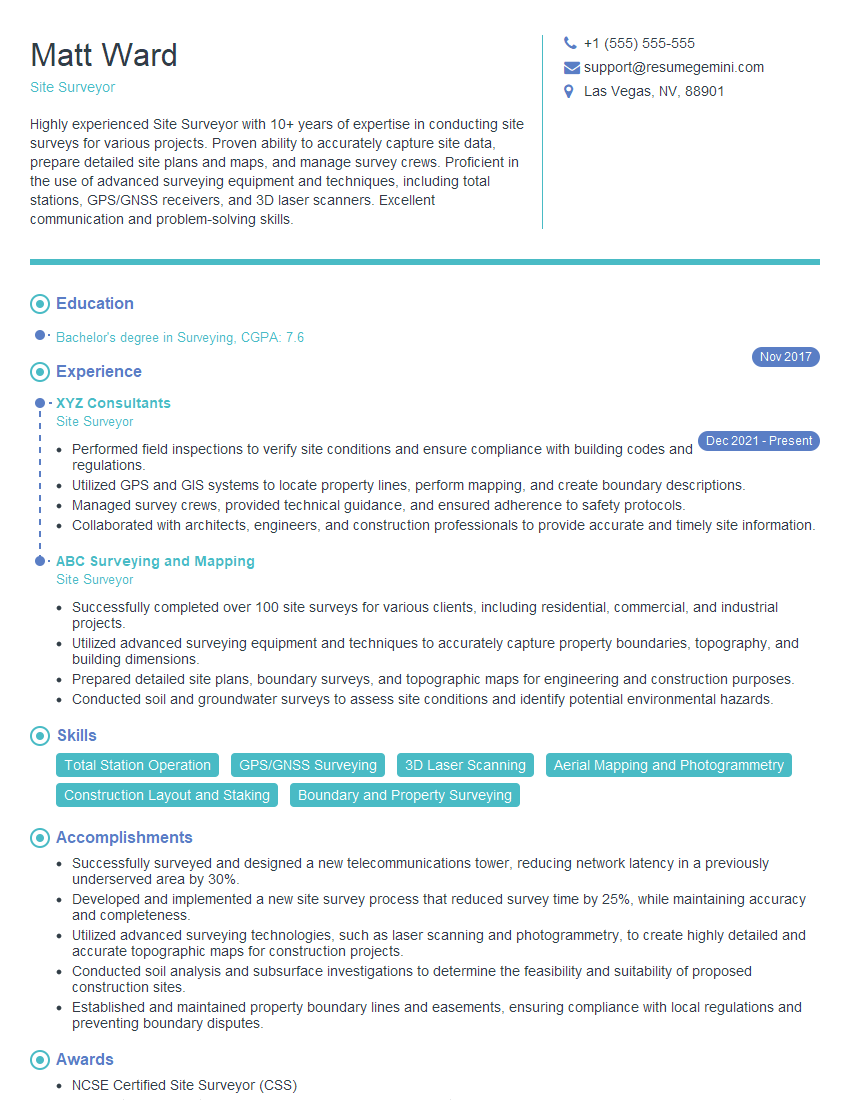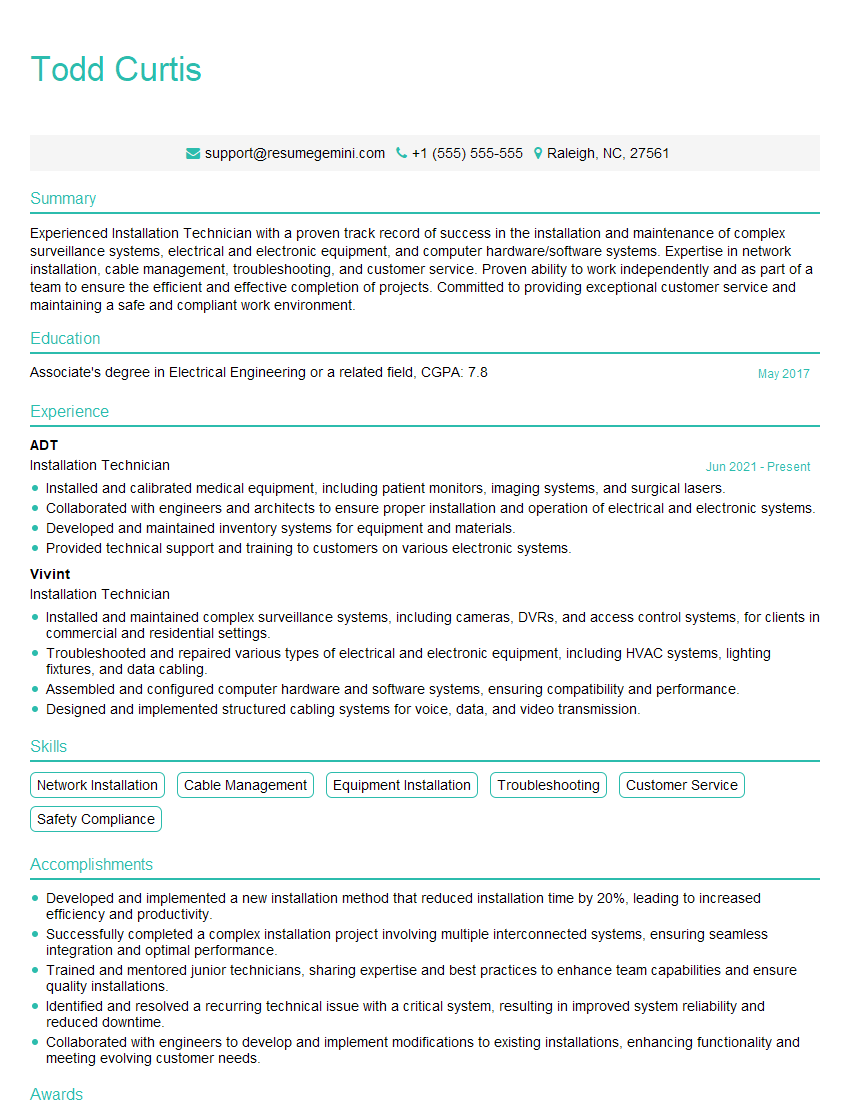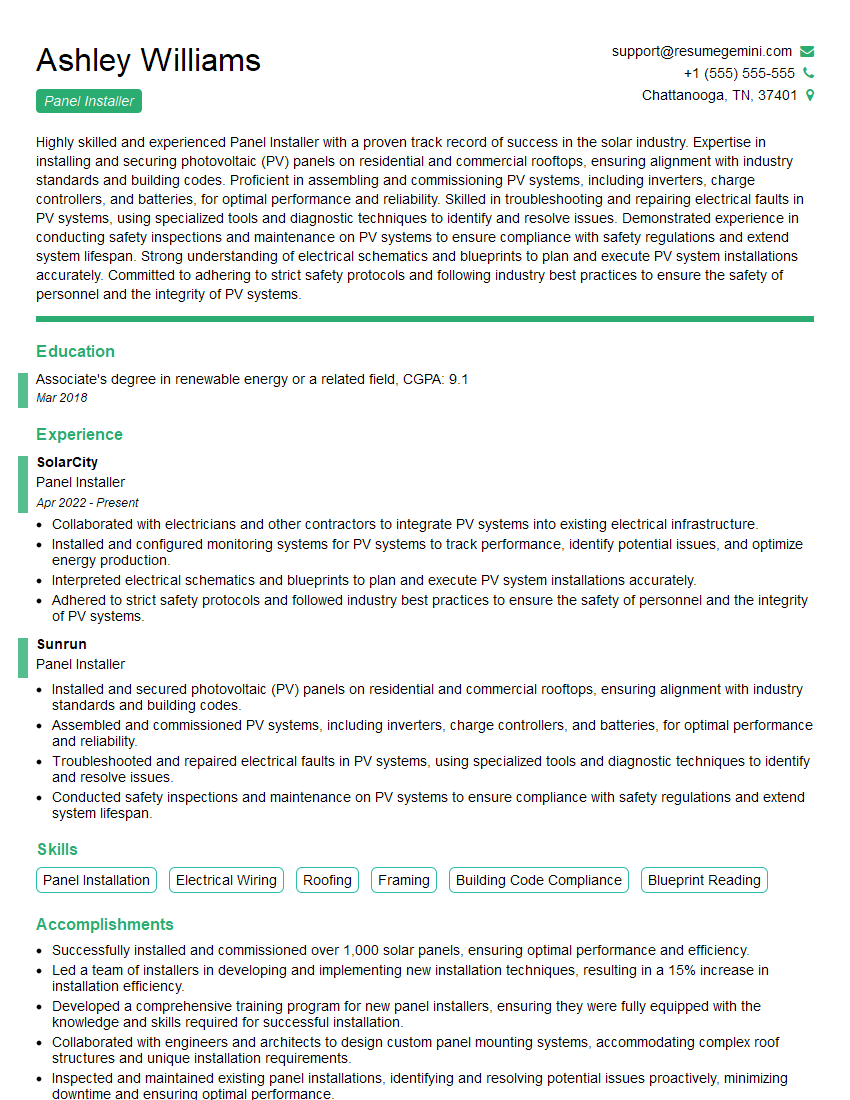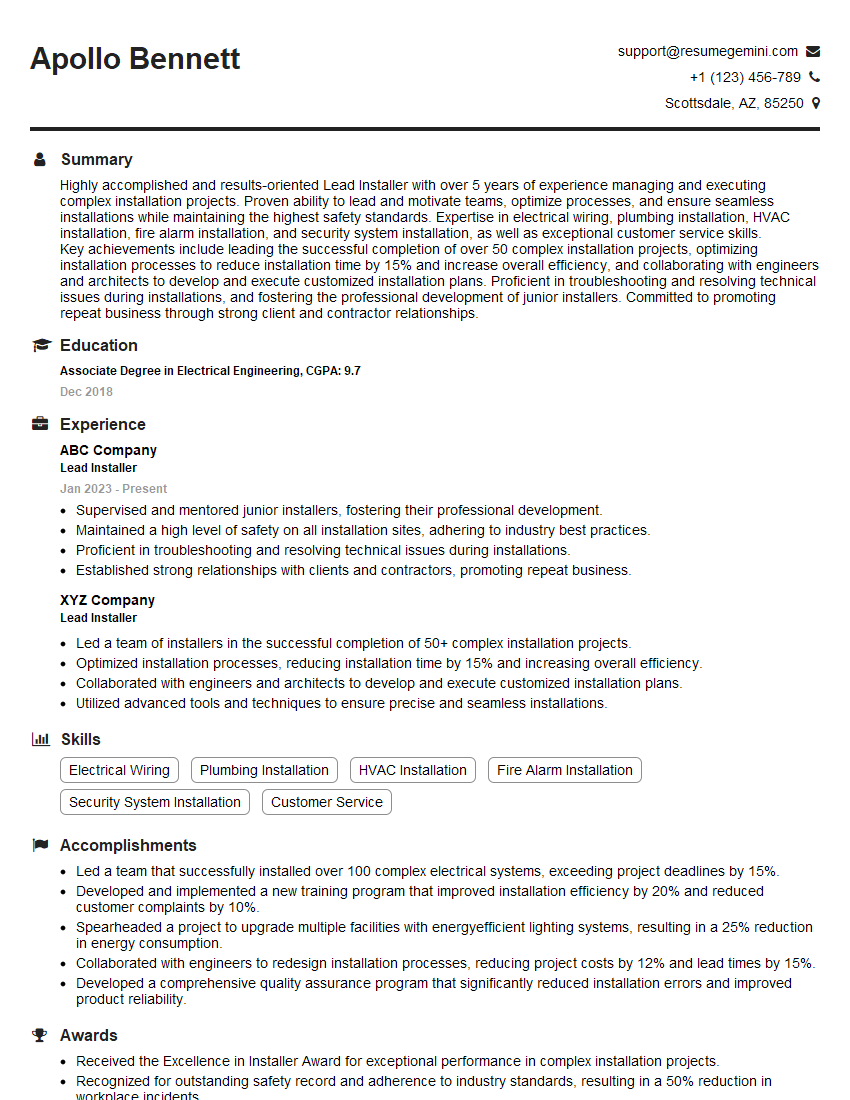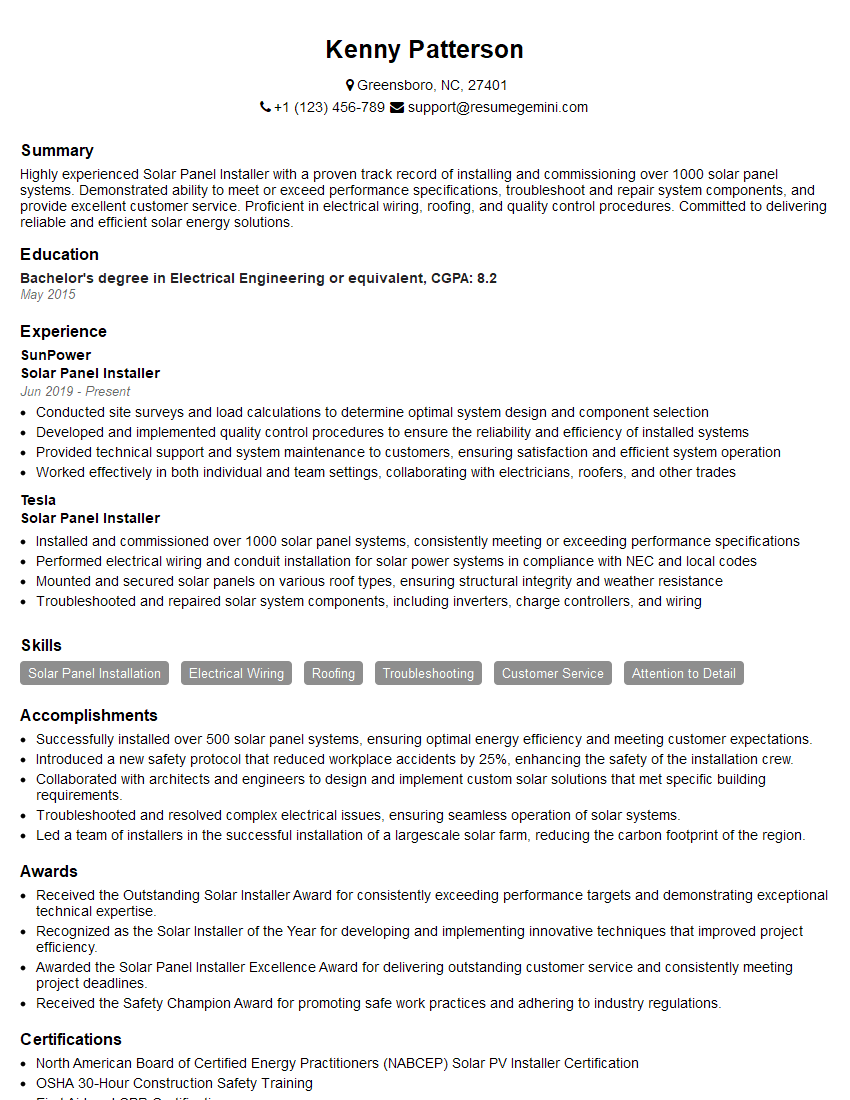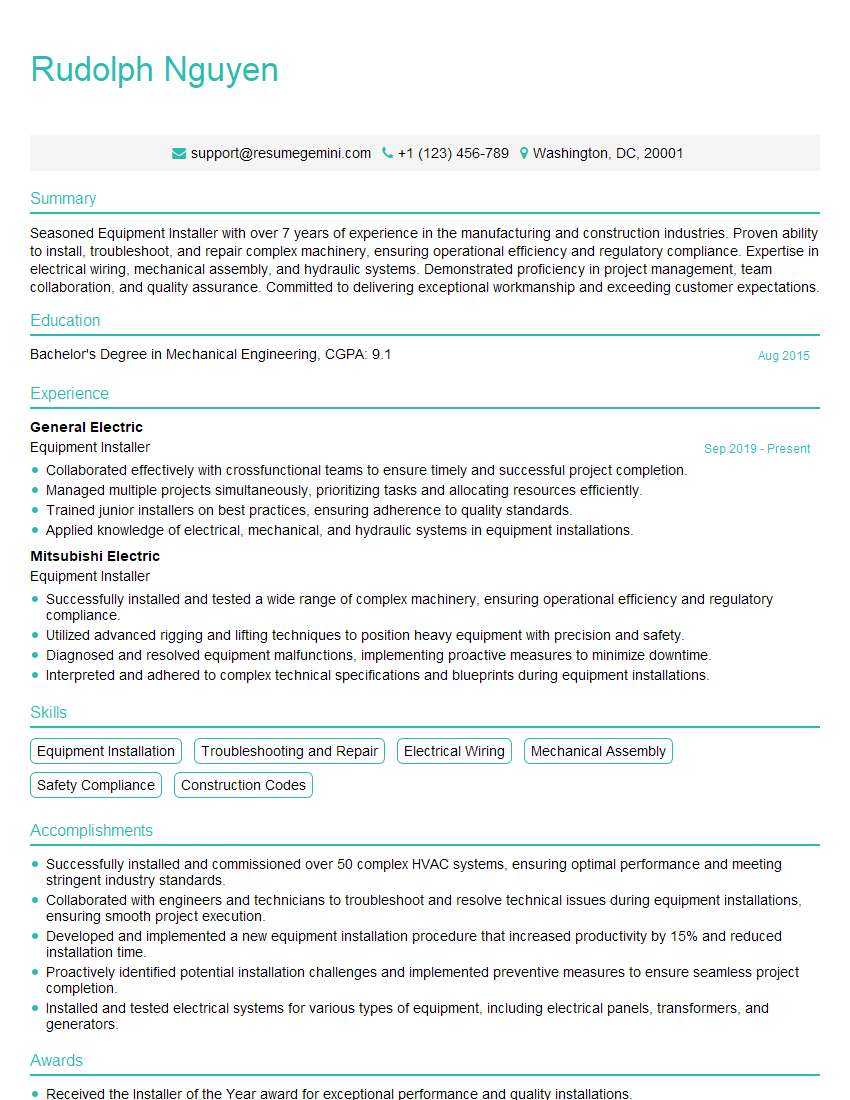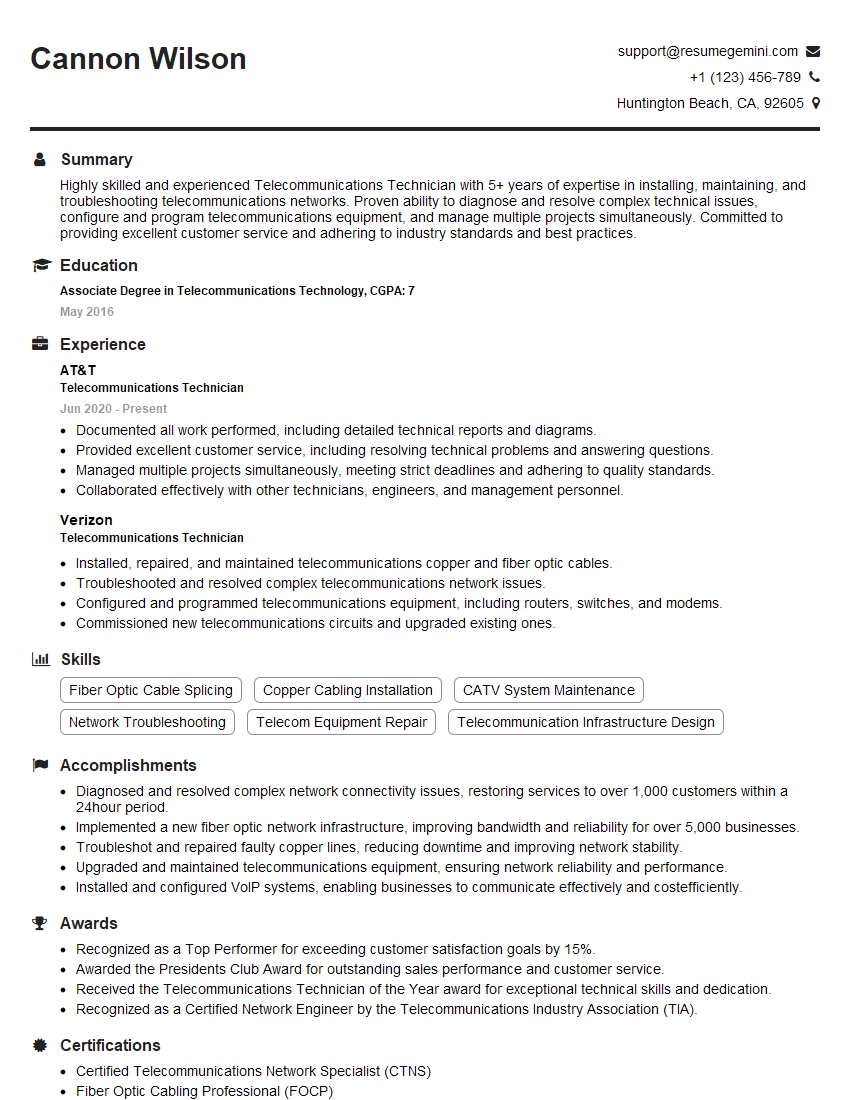Preparation is the key to success in any interview. In this post, we’ll explore crucial Panel Installation and Racking Systems interview questions and equip you with strategies to craft impactful answers. Whether you’re a beginner or a pro, these tips will elevate your preparation.
Questions Asked in Panel Installation and Racking Systems Interview
Q 1. Explain the different types of panel mounting systems.
Panel mounting systems vary greatly depending on the application and the type of panel being installed. Think of it like choosing the right hanger for a picture – a small picture needs a small hook, while a large, heavy one requires a more robust solution.
- Surface Mounting: This is the simplest method, ideal for smaller panels and lightweight applications. The panel is directly attached to a wall or surface using screws or adhesive. Think of a small junction box in a home.
- Flush Mounting: This method provides a cleaner, more integrated look by recessing the panel into the wall or surface. It requires cutting an opening in the wall to accommodate the panel’s dimensions. You often see this with larger electrical panels in commercial buildings.
- Recessed Mounting: Similar to flush mounting, but the panel sits deeper within the wall, providing even more protection and a sleeker appearance. This is frequently used in high-end installations or where aesthetics are critical.
- Rack Mounting: This is common for servers, networking equipment, and other IT infrastructure. The panel is mounted within a standard 19-inch rack using mounting ears or brackets. This allows for organized and standardized placement within a rack cabinet.
The choice of mounting system depends on factors like panel size, weight, environmental conditions, and aesthetic requirements.
Q 2. Describe the safety procedures for installing electrical panels.
Safety is paramount when installing electrical panels. A single mistake can have severe consequences. Imagine working with a live wire – the risk is immense.
- Lockout/Tagout (LOTO): Before commencing any work, always perform LOTO procedures to de-energize the panel completely. This involves physically locking out the power source to prevent accidental re-energization.
- Personal Protective Equipment (PPE): Use appropriate PPE, including insulated gloves, safety glasses, and arc flash clothing to protect against electrical hazards and potential arc blasts. This is non-negotiable.
- Proper Training: Only qualified and trained personnel should undertake electrical panel installations. This ensures a safe and compliant installation.
- Working at Heights: If installing panels at heights, utilize fall protection equipment and follow all relevant safety regulations. This is crucial to prevent falls.
- Grounding and Bonding: Ensure proper grounding and bonding to prevent electrical shock and equipment damage. All metal components must be properly grounded to eliminate potential hazards.
- Permitting: Obtain all necessary permits from relevant authorities prior to starting the work to ensure compliance with local regulations.
Regular safety inspections are crucial to detect any potential hazards and to implement corrective measures.
Q 3. What are the key considerations for grounding a racking system?
Grounding a racking system is critical for safety and equipment protection. It’s like providing a safe path for electricity to flow to the earth in case of a fault, preventing damage and hazards.
- Dedicated Grounding Conductor: A dedicated grounding conductor must be connected to the racking system’s frame. This typically involves connecting a grounding wire to a grounding lug on the rack itself.
- Grounding Continuity: Ensure good electrical continuity throughout the racking system by using appropriate grounding hardware and connections. This minimizes the risk of impedance causing hazardous voltage buildup.
- Grounding to Earth: The grounding conductor must ultimately be connected to a reliable earth ground, typically a dedicated grounding rod driven into the earth. This is essential to safely dissipate any electrical fault currents.
- Grounding Strips: Consider utilizing grounding strips within the rack for additional equipment grounding points to minimize impedance and maintain efficient earth grounding. This is important for multiple devices.
- Regular Inspection: Regularly inspect all grounding connections for corrosion, loose connections, or damage. This is to ensure ongoing safety and prevent risks.
Proper grounding significantly reduces the risk of electrical shock, equipment damage, and potential fires.
Q 4. How do you ensure proper cable management within a rack?
Proper cable management within a rack is essential for airflow, maintainability, and preventing damage. It’s like organizing a cluttered closet—much easier to find what you need and keeps things from getting damaged.
- Cable Ties and Straps: Use cable ties and straps to neatly bundle cables and keep them organized. Avoid over-tightening to prevent damage.
- Vertical Cable Managers: Utilize vertical cable managers to keep cables running vertically within the rack, preventing tangling and improving airflow.
- Labeling: Clearly label all cables to identify their purpose and destination. This is vital for easy troubleshooting and maintenance.
- Cable Trays and Baskets: Consider using cable trays or baskets for larger cable bundles to further improve organization and airflow.
- Proper Routing: Route cables in a manner that avoids strain or stress on connections. Overly bent cables can cause breaks over time.
Good cable management improves cooling efficiency, simplifying troubleshooting and maintenance while preventing damage to expensive equipment.
Q 5. Explain the process of installing a server rack.
Installing a server rack is a multi-step process involving careful planning and execution. Think of it as building a sturdy foundation for your IT infrastructure.
- Site Preparation: Ensure the chosen location is level, has sufficient weight capacity, and provides adequate ventilation.
- Rack Assembly: Assemble the rack frame according to the manufacturer’s instructions. Verify stability and structural integrity.
- Mounting: Securely mount the rack to the floor or wall using appropriate hardware and ensuring stability and leveling.
- Grounding: Install and verify the grounding connection, crucial for electrical safety.
- Cable Management: Install vertical cable managers and plan cable routing for efficient cable management.
- Equipment Installation: Carefully install servers and other equipment, ensuring proper racking and securing.
- Cable Connections: Connect all cables meticulously, paying close attention to labeling and organization.
- Testing: Thoroughly test all equipment and connections to ensure everything is working correctly before final commissioning.
Remember always to consult the manufacturer’s instructions for specific details on assembling and mounting your specific rack model.
Q 6. Describe your experience with different types of racking systems (e.g., 19-inch, 23-inch).
My experience encompasses a wide range of racking systems, predominantly 19-inch and, to a lesser extent, 23-inch racks. The 19-inch rack is the industry standard for IT equipment, while the 23-inch rack is often used for more substantial equipment or specific industrial applications.
- 19-inch Racks: I’ve worked extensively with various 19-inch rack configurations, including wall-mounted, floor-standing, and even specialized racks for specific environments such as data centers and telecom rooms. I’m familiar with different rack depths (e.g., 24 inches, 36 inches) and various manufacturers’ rack designs.
- 23-inch Racks: While less common, I have experience with 23-inch racks, mainly in industrial settings where larger equipment or custom configurations are needed. These often require more customized mounting solutions.
- Material Differences: I’ve worked with racks made from various materials, including steel, aluminum, and even specialized materials with enhanced environmental protection. Each material presents its unique challenges and benefits.
Understanding the nuances of different rack systems, including their load capacity, ventilation capabilities, and compatibility with different equipment, is key to a successful and safe installation.
Q 7. What tools and equipment are essential for panel installation?
The tools and equipment required for panel installation depend on the type of panel and the installation method. However, a well-equipped technician will have several essential tools.
- Screwdrivers: Various sizes and types of screwdrivers are necessary, including Phillips head, flathead, and possibly specialized bits for security screws.
- Wrench Set: A comprehensive set of wrenches is crucial for connecting and securing various components.
- Drill/Driver: A cordless drill/driver with various drill bits and driver bits is essential for faster and more efficient installation.
- Level: A level is needed to ensure panels are installed straight and plumb, particularly important for aesthetic reasons and functional operation.
- Measuring Tape: Accurately measuring distances and dimensions is paramount to ensure correct spacing and panel fit.
- Electrical Tester: A non-contact voltage tester is crucial for safety, ensuring the power is off before any work is done.
- Cable Management Tools: Cable ties, straps, and labels are vital for neat and organized cable management.
- Safety Equipment: Insulated gloves, safety glasses, and potentially arc flash suits are necessary for safety when working with electrical panels.
- Hole Saw Kit: Depending on the type of mounting, a hole saw kit may be needed to cut holes in walls or surfaces for flush mounting.
The specific tools and equipment required will vary depending on the complexity of the installation and the type of panel being installed.
Q 8. How do you troubleshoot common panel installation issues?
Troubleshooting panel installation issues begins with a systematic approach. First, I visually inspect the panel and surrounding area for obvious problems like loose wires, damaged components, or incorrect wiring. Then, I utilize testing equipment like multimeters and voltage testers to identify the specific fault. Common issues include incorrect breaker sizing leading to tripping, loose neutral connections resulting in voltage imbalances, and grounding problems causing electrical hazards.
- Example 1: A breaker keeps tripping. I’d first check the breaker’s amperage rating against the connected load’s current draw. An overloaded circuit is a common culprit. If the load is within the rating, I’d look for shorts in the wiring or faulty appliances.
- Example 2: Dim lighting or erratic appliance behavior could indicate a loose neutral. Testing voltage between the neutral and ground should show a minimal difference; a higher than normal reading suggests a problematic neutral connection.
Addressing the root cause is crucial. For instance, if a faulty wire is the problem, replacing it with a correctly sized and properly insulated wire is necessary. Documentation and clear labeling of all connections are essential for future troubleshooting.
Q 9. How do you ensure the structural integrity of a racking system?
Ensuring structural integrity in racking systems involves multiple considerations starting with the initial design phase. This includes proper load calculations – determining the weight of all equipment and ensuring the racks are rated to handle this load with a significant safety margin.
Correct installation is paramount. This includes anchoring the racks securely to the floor or wall using appropriate fasteners, considering the building’s load-bearing capabilities. Regular inspections are crucial to check for any signs of bending, sagging, or loose connections. Any signs of damage warrant immediate investigation and remediation.
- Example: When installing a server rack with heavy equipment, I’d use appropriate sized bolts and anchors, ensuring they penetrate the structural member adequately. I might also incorporate seismic bracing in earthquake-prone areas.
Regular maintenance includes tightening loose bolts and visually inspecting the system for signs of wear or damage. Using cable management solutions, like vertical cable managers, minimizes strain on the rack itself and prevents unbalanced loads. A well-maintained racking system will contribute significantly to the long-term reliability and safety of the infrastructure.
Q 10. Describe your experience with different types of panels (e.g., electrical, solar).
My experience encompasses various panel types. With electrical panels, I’m proficient in installing and troubleshooting low-voltage and high-voltage panels, adhering strictly to NEC codes. This includes working with various breaker types, busbars, and grounding systems. For example, I’ve worked extensively with Square D and Eaton panels in commercial and industrial settings.
In solar panel installations, I understand the specific requirements for grounding, mounting systems, and the intricacies of connecting panels in series and parallel configurations to maximize energy generation. I’m familiar with different panel technologies, including monocrystalline, polycrystalline, and thin-film solar panels, and their respective performance characteristics.
The key difference lies in the safety precautions and specialized knowledge required for each. While electrical panel installation prioritizes safety from electrical shock and fire, solar panel installation adds weather resistance and structural integrity to the critical concerns.
Q 11. What are the NEC (National Electrical Code) requirements for panel installation?
NEC (National Electrical Code) requirements for panel installation are extensive and crucial for safety. They cover various aspects, including:
- Proper Grounding: Ensuring effective grounding to prevent electrical shocks and protect equipment. This often involves using grounding rods and bonding conductors.
- Clearances and Spacing: Maintaining appropriate clearances around the panel for ventilation and accessibility, preventing overheating and ensuring safe working distances.
- Wiring Methods: Adhering to specific rules regarding wire types, sizing, and installation techniques to ensure proper current-carrying capacity and fire safety.
- Overcurrent Protection: Correct sizing of circuit breakers and fuses to prevent overloads and short circuits, safeguarding equipment and preventing fires.
- Overload Protection: The use of appropriate breakers, fuses, and other devices to prevent overcurrent conditions.
- Arc Flash Mitigation: Implementing measures to reduce the risk of arc flash incidents, including proper personal protective equipment (PPE) and procedures. This is especially vital in higher-voltage systems.
Non-compliance can lead to significant safety hazards, including electrical shocks, fires, and equipment damage. Regular inspections and adherence to the NEC are paramount for ensuring a safe and reliable electrical system.
Q 12. Explain the process of connecting power to a rack-mounted device.
Connecting power to a rack-mounted device requires careful attention to detail and safety. First, ensure the power is OFF at the breaker. Then, identify the device’s power requirements (voltage and amperage). Select the appropriate power cord and ensure the connector type is compatible. Route the power cord through the appropriate cable management system, securing it using appropriate cable ties to prevent strain.
Next, connect the power cord securely to both the device and the power source (PDU or wall outlet). After making the connection, visually inspect the wiring to ensure it’s clean, secure, and properly insulated. Finally, turn the power back ON at the breaker, monitor the device, and verify proper operation.
Important safety considerations include using appropriate personal protective equipment (PPE) like insulated gloves and eye protection. Always double-check your work before energizing any circuit.
Q 13. How do you manage cable strain relief within a rack?
Cable strain relief within a rack is critical for preventing damage to connectors and maintaining the integrity of the connections. Poor cable management leads to loose connections, damaged cables, and potentially dangerous situations.
I use various methods to manage cable strain:
- Strain Relief Clamps: These clamps are installed at the entry points of cables to secure them and prevent pulling or tension on the connectors.
- Cable Ties: Bundling cables neatly and securing them to the rack’s framework prevents tangling and reduces strain on connectors.
- Cable Managers: Vertical or horizontal cable managers organize cables, reduce clutter, and distribute weight evenly across the rack.
- Proper Cable Routing: Avoiding sharp bends or kinks, ensuring the cables have enough slack to avoid stress on the connectors.
By properly managing cable strain, I ensure the reliability of the rack’s systems and prevent costly repairs or downtime.
Q 14. Describe your experience with different types of cable pathways.
My experience includes a variety of cable pathways, each chosen based on factors like environment, aesthetic considerations, and the specific needs of the project.
- Raceways: These metal or plastic enclosures provide physical protection to cables, improving aesthetics and safety, particularly in areas with high foot traffic. I’ve used them in various commercial and industrial projects.
- Conduit: Metallic or non-metallic conduit is frequently used for underground or in-wall cabling, providing significant protection from damage and environmental factors. I’ve used PVC and metal conduit extensively in various settings.
- Cable Trays: These open or perforated metal trays are ideal for carrying large numbers of cables and providing a structured and easily accessible pathway. I commonly use these for organizing larger cabling infrastructure.
- Underfloor Pathways: Used in raised floor environments, these pathways provide a concealed and easily accessible route for cables beneath the floor. This is beneficial for clean aesthetics and easy maintenance.
The choice of cable pathway often depends on the specific application and its requirements, including load capacity, environmental protection, and cost considerations. Proper planning and execution are essential for a well-organized and safe cable infrastructure.
Q 15. What are the common causes of panel overheating?
Panel overheating is a significant concern in panel installation and racking systems, often stemming from inadequate ventilation, shading, or faulty equipment. Think of it like leaving your laptop running on a blanket – the heat has nowhere to escape.
- Poor Ventilation: Insufficient airflow around the panels prevents heat dissipation, leading to increased temperatures. This is particularly common in densely packed racks or enclosures with blocked vents.
- Shading: Panels, especially solar panels, need direct sunlight. Shading from trees, buildings, or even other panels can significantly reduce their efficiency and cause overheating due to inefficient energy conversion. Imagine trying to cook food in an oven that’s partially blocked.
- Faulty Equipment: Malfunctioning components like inverters or wiring can generate excessive heat. This can be similar to a short circuit in your home electrical system, causing overheating.
- High Ambient Temperature: Extremely hot environmental conditions can contribute to panel overheating, even with proper ventilation and design. This is analogous to leaving your car in direct sunlight on a hot day; the interior temperature skyrockets.
Addressing these issues involves proper planning, selecting appropriate ventilation systems, ensuring adequate spacing between panels, and regular maintenance checks.
Career Expert Tips:
- Ace those interviews! Prepare effectively by reviewing the Top 50 Most Common Interview Questions on ResumeGemini.
- Navigate your job search with confidence! Explore a wide range of Career Tips on ResumeGemini. Learn about common challenges and recommendations to overcome them.
- Craft the perfect resume! Master the Art of Resume Writing with ResumeGemini’s guide. Showcase your unique qualifications and achievements effectively.
- Don’t miss out on holiday savings! Build your dream resume with ResumeGemini’s ATS optimized templates.
Q 16. How do you prevent damage to panels during installation?
Preventing panel damage during installation requires a meticulous approach, starting from careful handling and continuing through secure mounting. We treat each panel like a precious piece of equipment.
- Proper Handling: Always use appropriate lifting equipment and techniques to avoid dropping or scratching panels. We typically use specialized straps and gloves. Imagine trying to install a large, delicate window – gentleness is crucial.
- Protective Packaging: Panels should be kept in their original packaging until the moment of installation to prevent scratches or impacts during transport.
- Secure Mounting: Panels must be properly fastened to the racking system using approved hardware and methods. This ensures they remain stable and withstand various environmental conditions. Think of building a sturdy house – a strong foundation is essential.
- Grounding and Bonding: Proper grounding and bonding prevent electrical surges that could damage the panels. This is a safety precaution that’s as vital as connecting a car’s battery to prevent sparking.
Regular inspections during and after installation are also critical to identify any potential damage early on.
Q 17. What are the different types of panel enclosures?
Panel enclosures come in a variety of types, each designed to meet specific needs and environmental conditions. The choice depends on factors like the size of the panels, the environment, and security requirements.
- Wall-Mount Enclosures: These are suitable for smaller systems and are often used in indoor applications where space is limited.
- Free-Standing Racks: These are self-supporting structures that can accommodate larger systems and are commonly used in data centers or industrial settings.
- Outdoor Enclosures: Designed for harsh weather conditions, these enclosures are weatherproof, and often include features like heating and cooling systems.
- Custom Enclosures: These are tailored to specific requirements and may include features such as specialized ventilation, security access controls, or environmental monitoring systems.
Material selection is also critical. Common materials include steel, aluminum, and polycarbonate, each offering different strengths and weaknesses. For example, steel provides excellent strength but can be heavier than aluminum.
Q 18. Describe your experience with working at heights.
I have extensive experience working at heights, having completed numerous projects involving rooftop installations and elevated racking systems. Safety is paramount, and I’m certified in fall protection techniques and always utilize appropriate safety equipment. This includes harnesses, lifelines, and fall arrest systems. I also understand and adhere to all relevant safety regulations.
For instance, on one project involving a multi-story building, we utilized a specialized lift system with trained operators to install panels safely and efficiently. Every step of a job at height requires meticulous planning and double-checking every safety measure.
Before beginning any work at heights, I always conduct a thorough risk assessment, including checking equipment, weather conditions, and any potential hazards.
Q 19. How do you ensure compliance with local building codes?
Ensuring compliance with local building codes is crucial and is an integral part of my work. This involves careful review of all relevant regulations before, during, and after installation. I am familiar with local and national electrical codes and other relevant standards.
For example, this might include obtaining necessary permits, adhering to specific grounding and bonding requirements, and ensuring proper clearances around equipment. This is akin to a builder getting building permits before construction.
I meticulously document all aspects of the installation, including permits obtained, inspections completed, and any deviations from standard procedures. This comprehensive documentation serves as proof of compliance during audits or inspections.
Q 20. How do you handle unexpected issues during installation?
Handling unexpected issues during installation requires a calm and methodical approach. This involves quick problem assessment, resourcefulness, and a proactive solution-finding approach. It’s similar to troubleshooting a computer problem: you start with identifying the issue, then testing solutions, and repeating the process.
For example, if a component arrives damaged, I would first document the damage with photos, contact the supplier for a replacement, and then implement a contingency plan to avoid delays.
In my experience, effective communication is essential. Keeping the client informed, discussing alternative solutions, and potentially bringing in specialized expertise help to resolve the issue quickly and efficiently.
Q 21. Explain your experience with preventative maintenance for racking systems.
Preventative maintenance for racking systems is vital to ensure their longevity and structural integrity. This includes regular inspections, cleaning, and tightening of connections.
This might involve checking for rust or corrosion, inspecting bolt tightness, and cleaning debris from the structure. Regular preventative maintenance is crucial, not only for the safety and reliability of the racking system but also for preventing costly repairs in the long term – it’s the equivalent of regular car maintenance.
My experience includes developing and implementing maintenance schedules, training clients on basic maintenance procedures, and providing recommendations on replacement parts as needed. A well-maintained system significantly reduces the risks associated with failures or collapses.
Q 22. Describe your experience with different types of racking hardware (e.g., bolts, screws, nuts).
My experience with racking hardware spans a wide range of fasteners, each chosen based on the specific application and load requirements. I’m proficient with various types of bolts, from standard machine bolts (often used for connecting rack rails to the floor or wall) to high-strength bolts (essential for heavy-duty server racks). I’m equally familiar with different screw types – self-tapping screws for thinner metal, pan head screws for general purpose fastening, and specialized screws like captive screws for improved security. Nuts, including hex nuts, wing nuts (for quick adjustments), and lock nuts (crucial for preventing vibration-induced loosening), are also integral to my toolkit. Understanding the different strengths and applications of these hardware components is critical to ensuring a safe and stable rack system. For instance, I wouldn’t use a self-tapping screw to secure a heavy server; the shear strength wouldn’t be sufficient. Instead, I’d utilize appropriately sized and rated machine bolts with lock washers and nuts.
In one project involving a high-density server room, we used specialized vibration-dampening washers in conjunction with high-strength bolts to mitigate the risk of equipment damage caused by vibrations from the servers themselves. This illustrates the importance of selecting the right hardware for the specific environmental conditions and loads.
Q 23. How do you determine the appropriate load capacity for a racking system?
Determining the appropriate load capacity for a racking system is a crucial step that involves several considerations. First, I carefully review the manufacturer’s specifications for both the rack itself and any individual components (shelves, rails, etc.). These specifications will provide a maximum load rating per shelf or bay. However, this rating is just a starting point. I then assess the weight of the equipment that will be housed within the rack. This might involve weighing individual pieces of equipment or using manufacturer data sheets. Next, I consider the distribution of weight within the rack. Uneven weight distribution can significantly impact stability, so I always strive for a balanced layout. Finally, I include a safety factor. I typically add a 20-30% margin to account for unforeseen circumstances, like heavier equipment being added in the future, or potential seismic activity in the area. Ignoring this margin can lead to catastrophic failure of the entire rack system. For example, if a manufacturer specifies a maximum load of 1000lbs per shelf, and I plan on using that shelf to support 800lbs of equipment, I would not install it without verifying the shelf’s ability to accommodate 800 lbs based on the design and materials used. I’d also ensure that the overall rack capacity isn’t exceeded. If the rack design itself has a limited capacity, it is useless to have individual shelves with higher capacity.
Q 24. How do you document the installation process?
Documentation is paramount in panel installation and racking systems. I meticulously document every step of the installation process, ensuring clear and concise records. My documentation typically includes:
- Detailed photographs at each stage of the assembly process, especially critical connections and cable management.
- Schematics and diagrams, showing the layout and connections of components, often directly referencing the CAD drawings.
- Written notes documenting any deviations from the original plan, any challenges encountered, and how they were overcome. This includes details like serial numbers of components and any special instructions.
- Equipment inventories, listing all the components used in the project.
- Testing and commissioning reports which clearly show that all components are functioning correctly.
This comprehensive approach ensures proper maintenance and future troubleshooting. In case of an issue, it is invaluable to have documentation readily available. A well-documented project simplifies any future modifications or repairs.
Q 25. Describe your experience with testing and commissioning of panel installations.
Testing and commissioning are critical to ensure the safe and reliable operation of the panel and rack installations. This process typically involves:
- Visual inspection: Verifying that all components are correctly installed, securely fastened, and free from damage.
- Functionality checks: Testing all equipment housed within the rack to confirm proper operation.
- Load testing: Applying a controlled load to the racking system to verify that it meets its design specifications. This may involve simulating the full load expected or even exceeding it slightly to create a margin of safety.
- Thermal checks: Monitoring temperatures within the rack to ensure adequate cooling and prevent overheating of equipment.
- Cable integrity checks: Inspecting all cabling for proper connections and strain relief.
Following a rigorous testing procedure, I generate a detailed commissioning report that summarizes the results and documents that the installation meets all safety and performance requirements. This includes recording all discrepancies found and the steps taken to resolve them. In one instance, a load test revealed a slight instability in a section of the rack; careful re-tightening of bolts immediately rectified the problem, preventing potential future failures.
Q 26. Explain your experience with using CAD drawings for panel and rack installations.
CAD drawings are indispensable tools in my work. I use them extensively to plan the layout of panel and rack installations, ensuring efficient space utilization and minimizing cable clutter. Before any physical installation begins, I thoroughly review the CAD drawings. I pay close attention to dimensions, component placement, and cable routing. The drawings help me anticipate potential challenges and plan the installation steps accordingly. I often use software that allows for 3D modelling, which helps visualize the entire project before installation. This process reduces installation time and minimizes potential errors. It also allows for more collaboration with other teams in the project. Using the CAD drawings as a visual guide to ensure accurate placement of equipment is crucial for a neat, organized, and functional rack.
For example, in a recent project, using the CAD software allowed me to optimize cable routing, reducing the overall cable length and improving airflow within the rack. This detail significantly contributed to the system’s thermal efficiency and operational longevity.
Q 27. How do you maintain a clean and organized workspace during installation?
Maintaining a clean and organized workspace is paramount for efficiency and safety. Before I even begin the installation, I designate specific areas for tools, materials, and discarded components. I use clearly labeled containers and bins to keep everything sorted. During the installation, I regularly clean up debris and unused materials. Keeping the workspace organized not only prevents accidents caused by clutter but also aids in better tracking of materials, ensuring nothing goes missing and that I have all the parts I need in a timely manner. Cable management is a crucial aspect of organization, and I use cable ties, labels, and sleeves to maintain a neat and orderly arrangement of cables. This enhances the overall aesthetics and reduces the risk of damage and future maintenance headaches.
I often use a 5S methodology (Sort, Set in Order, Shine, Standardize, Sustain) as a framework for workplace organization. This systematic approach helps to ensure a consistently clean and efficient work environment throughout the entire project.
Q 28. What are your preferred methods for securing equipment within a rack?
Securing equipment within a rack is critical for safety and system stability. My preferred methods depend on the type of equipment and the rack’s design but generally involve a combination of the following:
- Rack mounting ears/brackets: These are specifically designed for various equipment types and provide a sturdy and reliable mounting solution. Always ensure compatibility between the ears and the equipment they’ll support.
- Cage nuts and screws: These are essential for secure fastening to the rack’s mounting rails and ensure a firm grip, especially on heavier equipment.
- Cable ties and straps: For securing cables and preventing them from becoming tangled or damaged. Always choose ties that are appropriate for the cable diameter and weight.
- Anti-vibration mounts: For sensitive equipment, these help minimize the impact of vibrations, extending the lifespan of the components.
I always prioritize using manufacturer-recommended methods for securing equipment, referring to both equipment and rack documentation. This ensures compliance with safety regulations and optimizes system performance. Improper securing techniques can lead to equipment damage, system instability, and even safety hazards, so attention to detail here is very important.
Key Topics to Learn for Panel Installation and Racking Systems Interview
- Safety Procedures and Regulations: Understanding and adhering to relevant safety standards, including lockout/tagout procedures, fall protection, and proper use of personal protective equipment (PPE).
- Tools and Equipment: Familiarity with various hand tools, power tools, and specialized equipment used in panel installation and racking systems, including their proper usage and maintenance.
- Blueprint Reading and Interpretation: Ability to accurately read and interpret blueprints, schematics, and other technical drawings to understand the project requirements.
- Panel Assembly and Mounting: Knowledge of different panel types, mounting techniques, and securing methods to ensure structural integrity and compliance with specifications.
- Racking System Design and Configuration: Understanding various racking system designs, their applications, and the factors influencing optimal configuration (weight capacity, space limitations, etc.).
- Wiring and Cabling Techniques: Proficiency in proper wiring and cabling techniques within the racking system, adhering to industry best practices and safety standards.
- Troubleshooting and Problem-Solving: Ability to identify and resolve common issues encountered during installation, such as misalignment, faulty components, or cabling problems.
- Quality Control and Inspection: Understanding quality control procedures and conducting thorough inspections to ensure the system meets specifications and safety standards.
- Project Management Basics: Familiarity with basic project management principles, including scheduling, resource allocation, and progress tracking.
Next Steps
Mastering Panel Installation and Racking Systems opens doors to exciting career opportunities in various industries, offering excellent growth potential and competitive salaries. A strong resume is your key to unlocking these opportunities. Creating an ATS-friendly resume is crucial for getting your application noticed by recruiters. ResumeGemini can help you build a professional and effective resume tailored to highlight your skills and experience in this specialized field. We provide examples of resumes specifically designed for Panel Installation and Racking Systems professionals to give you a head start. Use ResumeGemini to build a resume that truly showcases your expertise and helps you land your dream job.
Explore more articles
Users Rating of Our Blogs
Share Your Experience
We value your feedback! Please rate our content and share your thoughts (optional).
What Readers Say About Our Blog
This was kind of a unique content I found around the specialized skills. Very helpful questions and good detailed answers.
Very Helpful blog, thank you Interviewgemini team.
